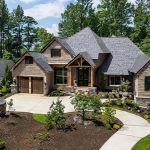Welcome to the world of energy-efficient home design, where sustainability meets style and comfort! Building or renovating a home with energy efficiency in mind not only helps reduce your carbon footprint but also saves you money on utility bills and creates a healthier living environment. In this guide, we’ll explore the principles of energy-efficient design and provide practical tips for creating a home that’s as eco-friendly as it is beautiful.
Understanding Energy-Efficient Design
Energy-efficient design is all about maximizing the performance of your home while minimizing energy consumption. It involves integrating various design elements, materials, and technologies to optimize energy efficiency and reduce environmental impact. From insulation and air sealing to lighting and appliances, every aspect of your home plays a role in its overall energy performance.
Key principles of energy-efficient design include:
- Maximizing insulation and air sealing to minimize heat loss and air leakage
- Using high-performance windows and doors to optimize natural light and ventilation
- Choosing energy-efficient appliances and lighting fixtures to reduce electricity usage
- Integrating renewable energy sources, such as solar panels or geothermal heat pumps, to generate clean, renewable power onsite
By incorporating these principles into your home design, you can create a comfortable, sustainable living space that benefits both you and the planet.
Practical Tips for Energy-Efficient Home Design
Now that you understand the basics of energy-efficient design, let’s dive into some practical tips for implementing these principles in your own home:
1. Start with a Smart Design
Efficient home design begins with thoughtful planning and layout. Consider factors such as orientation, site conditions, and natural resources to optimize passive heating, cooling, and lighting. Position windows and doors to capture natural daylight and prevailing breezes, reducing the need for artificial lighting and mechanical ventilation.
| Key Considerations for Smart Design |
|---|
| Orientation for passive heating and cooling |
| Maximizing natural daylight |
| Optimizing natural ventilation |
Additionally, minimize heat loss and gain by designing compact, well-insulated building envelopes with minimal thermal bridging.
2. Invest in High-Performance Insulation and Windows
Proper insulation and high-performance windows are essential components of energy-efficient home design. Choose insulation materials with high R-values and low thermal conductivity to minimize heat transfer through walls, floors, and roofs. Consider advanced insulation techniques, such as spray foam or blown-in insulation, for maximum effectiveness.
- High R-value insulation
- Low-E (emissivity) windows
- Insulated window frames
Similarly, select windows with low-E coatings, insulated frames, and multiple glazing layers to reduce heat loss in winter and heat gain in summer while maximizing natural light and views.
3. Opt for Energy-Efficient Appliances and Lighting
When choosing appliances and lighting fixtures for your home, opt for models with high energy efficiency ratings, such as ENERGY STAR-certified products. Look for energy-efficient features such as LED lighting, programmable thermostats, and energy-saving modes that help reduce electricity consumption and operating costs.
| Features of Energy-Efficient Appliances |
|---|
| ENERGY STAR certification |
| LED lighting |
| Programmable thermostats |
Additionally, incorporate natural lighting strategies, such as skylights and solar tubes, to minimize the need for artificial lighting during the day.
4. Harness the Power of Renewable Energy
Consider integrating renewable energy systems, such as solar panels, wind turbines, or geothermal heat pumps, to generate clean, renewable power onsite. Evaluate your home’s energy needs and potential renewable resources to determine the most suitable system for your location and budget.
- Solar photovoltaic (PV) panels
- Wind turbines
- Geothermal heat pumps
By harnessing the power of renewable energy, you can reduce your dependence on fossil fuels, lower your carbon footprint, and achieve greater energy independence.
Conclusion
Energy-efficient home design is not just a trend – it’s a smart investment in the future of our planet and our communities. By incorporating sustainable design principles, investing in high-performance materials and technologies, and embracing renewable energy sources, you can create a home that’s comfortable, cost-effective, and environmentally friendly.
So, why wait? Start planning your energy-efficient dream home today and join the movement toward a greener, more sustainable future!


